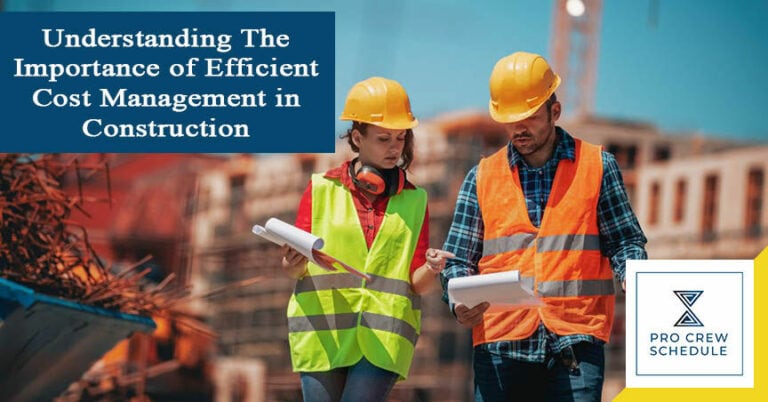When managing construction, a project manager aims to complete your project on time, within budget, and of the highest quality possible. As a result, keeping track of time, materials, and labor costs is the key to successful project delivery. In an article in Science Direct entitled Impact of inflation rate on construction projects budget: A review, inflation rates are often neglected in budgeting, causing an overrun as prices of building materials, wages for workers, and rates for renting machinery change every year (Impact of inflation rate on construction projects budget: A review – ScienceDirect). This makes managing costs a complex challenge, and it is essential to have enough cash flow to cover costs when they come up.
There are lots of ways to spend money and lots of ways for costs to get out of hand. If your project takes a long time, consider future costs, income, and inflation in your budget. In this article, let us look at construction cost management, its steps, and the factors affecting it. We have also listed several ways that you can utilize to improve the way you manage costs.
Defining What Construction Cost Management Is
In a nutshell, construction cost management is the process of planning and keeping track of a project’s budget and spending. Managing costs is done in every project’s life cycle, from planning and allocating the budget to controlling costs. It also involves evaluating the project’s cost performance once it is done to see its profitability. Regardless of the project’s size, scope, or complexity, staying on budget can take time and effort. As a result, you will need to utilize effective and efficient project cost management to ensure a project is finished on time, on budget, and as planned.
The Four Steps to Managing Construction Costs
As stated earlier, construction cost management is a way to ensure that project costs and budgets stay on track from start to finish. When done well, it will lead to accurate cost estimates and spending that matches those numbers, and this makes it even easier to keep everything under control and boosts profitability. In this section, let us look at the four steps involved in construction cost management.
Planning Your Resources, Inventory, and Equipment
The first step is planning all the necessary resources, inventory, and equipment. You must review your project deliverables, develop work breakdown structures, and list all the activities and tasks needed to complete them. This will give you a clear idea of what resources you need for a specific activity, and add them up to get an overview of how much those resources will cost for the whole project.
Estimate Your Costs
The next step is to estimate your costs for how much all the resources needed for the project will likely cost. This includes your labor, subcontracts, materials, plant and building equipment, services and facilities, inflation allowances, and costs for unforeseen problems. Look at how much your past jobs cost and make accurate estimates.
Create Your Budget
Once you have your estimated costs, create a project budget or cost baseline that can be used to track and measure performance. It is a great way to ensure your job stays on track while it is being done. How you are spending your budget is an indication of how long the job can take to finish. This goes hand-in-hand with construction scheduling, which lets you know how much budget is allotted and should be spent for every milestone.
Controlling Costs and Managing Expenses
The last step is to control your costs. It is the process of keeping track of how a project is going so that the budget can be kept up to date and changes to the cost standard can be handled. Cost control is keeping all the spending within budget by observing and judging how the project progresses.
Critical Factors That May Have An Effect on Your Construction Budget
Most clients care most about how much a project will cost to build. As a result, general contractors and project managers often look for ways to reduce costs and save money without compromising quality.
Several factors affect a building project’s actual cost and should be considered when estimating costs or creating your budget. In this section, we have listed critical factors that should be considered.
Labor Costs
The labor costs are the wages given to crew members working on the project, including all employee benefits and taxes. When making a budget for a project, it is essential to include the cost of labor since several people may be working on the project simultaneously. ]Wages can also vary from place to place and can escalate depending on the current times. So, the area wage rate and possible inflation should be considered in your costs.
Material and Equipment Costs
The total cost of all the supplies and tools needed for a job is the cost of materials. This includes ordering supplies before the project starts, while the project is being done, and after the project is done. Construction material costs include material prices, shipping charges, and applicable taxes.
Site Conditions
Conditions on the project site can make construction prices go up. Site conditions like poor soil, wetlands, contaminated materials, conflicting utilities, or natural terrain can increase the cost of a project. For example, your project site is far from your headquarters. Maybe you should include transportation costs in your budget, and costs can quickly go out of hand if these differences are not considered.
Construction Schedule
Your costs are also affected by how long the project will take. Due to higher indirect costs, a more extended project can make building costs go up. At the same time, direct costs go up when building costs go down, which makes the project cost more. Luckily, you can utilize construction schedule software to create your scope, cost, and schedule baselines, allowing you to keep track of everything going on with your project.
Plans and Specifications
The time it takes to complete that project is cut down when the plans and specs are complete, and the work is done quickly and correctly on the site. Any wording that may cause confusion and lead to possible change orders will lead to higher building costs.
Return On Investment and Profitability
Return on investment (ROI) measures how worthwhile a project is about how much money was put into it. If the return on investment (ROI) is high, the project makes more money than it costs, boosting your company’s profitability. This will allow you to take on more projects in the future.
How To Improve Your Cost Management Process
Managing and controlling costs is essential to the project’s success. Many projects utilize new technologies, platforms, and solutions for every step of the project lifecycle to continuously improve how they manage costs. In this section, let us look at a few simple strategies that you can consider to create a more efficient and effective cost management system.
Use A Construction Scheduling Software
Construction software can offer robust features and automation that can help bring together processes for controlling costs like budget and contract management, payment applications, and change orders with just a few simple clicks. Having valuable data and insights, such as a summary of all budget items and contracts, revenue, costs, forecast, and variance in one platform, gives you real-time information on your project’s financial health. It also ensures that teams always have the most up-to-date and correct cost information, whether on the job site or in the office.
Create Accurate Cost Estimates
Estimation can make or break your project’s success because wrong estimates can cost you bids, cut your profits, and even hurt your reputation in the long run. Your cost estimates and budget planning for cost control must be thorough. Many things can make it hard to make accurate estimates, like different supplier costs or steadily increasing material costs due to inflation.
Track All Your Costs and Budget in Real-Time
Knowing the status of your construction budget in real-time is essential to keep your finances on track. You can utilize software to see a list of all your budget items and things that affect costs as they come up. This will make it easier to make accurate predictions and keep track of costs as the job progresses.
Integrate All Your Project Contracts
Suppose you still manage your project with spreadsheets, folders, and documents. In that case, you might need help finding documents related to your trade partners, subcontractors, or suppliers. With the right tools for managing costs, you can make, change, and look at contracts faster and all in one place. Your crew can easily see the one-time cost items for a given supplier, making it easier to find relevant information at a simple glance.
Optimize Your Change Order Process
Change orders are additional tasks meant to change a project’s course in ways that were not planned. This inevitably leads to cost adjustments that can sometimes take time to handle. As a result, the change order process needs to be optimized. You can utilize crew schedule software to improve visibility on each task, creating clear accountability and ensuring nothing slips through the cracks.
Focus on Strong Communication and Collaboration
The more you and your team communicate and collaborate, the more likely you will stay on budget. You can keep from going over budget if your team knows what they need to do and when and if you give them the tools they need when they need them.
Ensure everyone is on the same page by providing access to real-time information. You can also have your team send you daily reports on what is happening at the job sites, so you will be less likely to find nasty surprises when looking at your budget at the end of the job.







